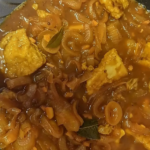In the culinary traditions of East Africa, Kachumbari stands out as a refreshing and vibrant tomato and onion salad. This simple yet flavorful dish is a staple in Kenyan, Tanzanian, and Ugandan cuisine, known for its ability to brighten up any meal with its zesty and tangy flavors. With just a handful of ingredients, Kachumbari offers a delightful burst of freshness that complements a wide range of dishes.
Origins and Cultural Significance
Kachumbari has deep roots in the culinary heritage of East Africa. Its origins can be traced back to the Swahili culture, which thrived along the eastern coast of Africa and served as a melting pot of various influences, including Arabic, Indian, and local African flavors. The dish has since spread across the region, becoming a beloved accompaniment to many meals.
The Ingredients
The essence of Kachumbari lies in its simplicity. The primary ingredients are ripe tomatoes and onions, which form the base of the salad. These are often combined with fresh cilantro (coriander) and finely chopped green chilies, which contribute to the vibrant flavors and add a hint of spiciness.
Additional variations of Kachumbari may include other ingredients such as cucumber, bell peppers, or avocado, depending on personal preferences and regional variations. However, the core components of tomatoes, onions, cilantro, and chilies remain constant.
The Preparation
Preparing Kachumbari is a straightforward process that requires minimal effort. The tomatoes are diced into small pieces, and the onions are thinly sliced. These are then combined in a bowl, along with the chopped cilantro and green chilies. The salad is lightly seasoned with salt and freshly squeezed lemon or lime juice, which adds tanginess and enhances the flavors of the vegetables.
The salad is typically tossed gently to ensure the ingredients are well mixed and the flavors are evenly distributed. It can be served immediately or refrigerated for a short time to allow the flavors to meld together.
A Burst of Freshness
The beauty of Kachumbari lies in its vibrant and fresh flavors. The juicy tomatoes bring a burst of sweetness, while the sharpness of the onions adds a delightful bite. The aromatic cilantro adds a hint of citrusy freshness, while the green chilies provide a subtle kick of heat. The combination of these ingredients creates a harmonious balance of flavors, resulting in a salad that is both zesty and invigorating.
Versatility and Serving Suggestions
Kachumbari’s versatility allows it to complement a wide range of dishes. It pairs wonderfully with grilled meats, fish, or poultry, adding a refreshing element to the rich flavors of the main course. It can also be served alongside staple foods such as chapati, rice, or ugali (a maize-based porridge). Kachumbari’s vibrant colors and flavors make it an appealing addition to any plate, enhancing the overall dining experience.
Beyond its role as a side dish, Kachumbari has cultural significance in East African communities. It is often enjoyed during festive occasions, family gatherings, and social events, where it brings people together to celebrate and share meals.
East African Kachumbari is a testament to the simplicity and vibrancy of East African cuisine. With its fresh and zesty flavors, this tomato and onion salad adds a burst of brightness to any meal. Whether you’re exploring the markets of Nairobi, enjoying a meal in Dar es Salaam, or recreating the flavors of East Africa in your own kitchen, don’t miss the opportunity to savor the refreshing and tangy delight of Kachumbari.








